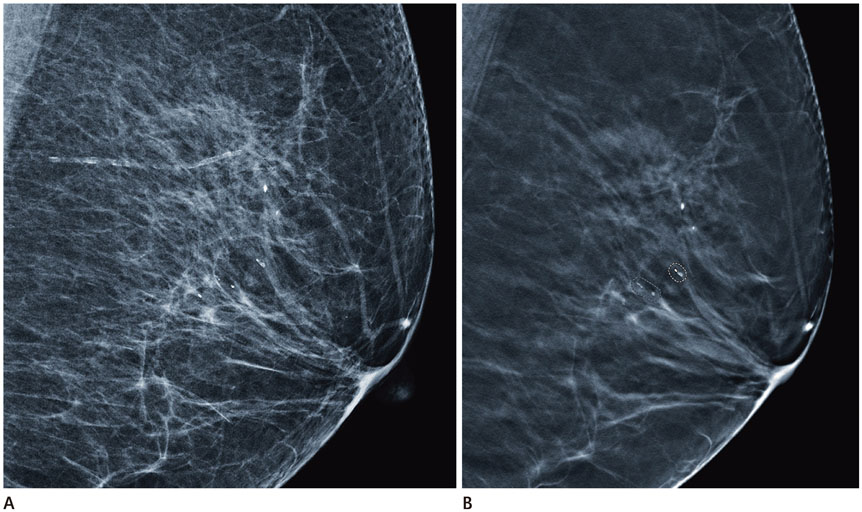J Korean Soc Radiol.
2017 Aug;77(2):105-112. 10.3348/jksr.2017.77.2.105.
3D Computer-Aided Detection for Digital Breast Tomosynthesis: Comparison with 2D Computer-Aided Detection for Digital Mammography in the Detection of Calcifications
- Affiliations
-
- 1Department of Radiology, Seoul National University College of Medicine, Seoul National University Hospital, Seoul, Korea. river7774@gmail.com
- 2Department of Radiology, SMG-SNU Boramae Medical Center, Seoul National University College of Medicine, Seoul, Korea.
- 3Department of Radiology, Kyungpook National University School of Medicine, Kyungpook National University Hospital, Daegu, Korea.
- 4Department of Radiology, Korea University College of Medicine, Korea University Anam Hospital, Seoul, Korea.
- KMID: 2386747
- DOI: http://doi.org/10.3348/jksr.2017.77.2.105
Abstract
- PURPOSE
To retrospectively evaluate the performance of 3D computer-aided detection (CAD) for digital breast tomosynthesis (DBT) in the detection of calcifications in comparison with 2D CAD for digital mammography (DM).
MATERIALS AND METHODS
Between 2012 and 2013, both 3D CAD and 2D CAD systems were retrospectively applied to the calcification data set including 69 calcifications (31 malignant calcifications and 38 benign calcifications) and the normal data set including 20 bilateral normal mammograms. Each data set consisted of paired DBT and DM images. Sensitivities for the detection of malignant calcifications were calculated from the calcification data set. False-positive mark rates were calculated from the normal data set. They were compared between the two systems.
RESULTS
Sensitivities of 3D CAD [100% (31/31) at levels 2, 1, and 0] were same as those of the 2D CAD system [100% (31/31) at levels 2 and 1] (p = 1.0, respectively). The mean value of false-positive marks per view with 3D CAD was higher than that with 2D CAD at level 2 (0.52 marks ± 0.91 vs. 0.07 marks ± 0.26, p = 0.009).
CONCLUSION
3D CAD for DBT showed equivalent sensitivity, albeit with a higher false-positive mark rate, than 2D CAD for DM in the detection of calcifications.
MeSH Terms
Figure
Cited by 1 articles
-
Digital Breast Tomosynthesis Screening
Eun Young Chae, Hak Hee Kim
J Korean Soc Radiol. 2019;80(1):19-31. doi: 10.3348/jksr.2019.80.1.19.
Reference
-
1. Friedewald SM, Rafferty EA, Rose SL, Durand MA, Plecha DM, Greenberg JS, et al. Breast cancer screening using tomosynthesis in combination with digital mammography. JAMA. 2014; 311:2499–2507.2. Ciatto S, Houssami N, Bernardi D, Caumo F, Pellegrini M, Brunelli S, et al. Integration of 3D digital mammography with tomosynthesis for population breast-cancer screening (STORM): a prospective comparison study. Lancet Oncol. 2013; 14:583–589.3. Rafferty EA, Park JM, Philpotts LE, Poplack SP, Sumkin JH, Halpern EF, et al. Assessing radiologist performance using combined digital mammography and breast tomosynthesis compared with digital mammography alone: results of a multicenter, multireader trial. Radiology. 2013; 266:104–113.4. Houssami N, Skaane P. Overview of the evidence on digital breast tomosynthesis in breast cancer detection. Breast. 2013; 22:101–108.5. Kim SA, Chang JM, Cho N, Yi A, Moon WK. Characterization of breast lesions: comparison of digital breast tomosynthesis and ultrasonography. Korean J Radiol. 2015; 16:229–238.6. Wei J, Chan HP, Hadjiiski LM, Helvie MA, Lu Y, Zhou C, et al. Multichannel response analysis on 2D projection views for detection of clustered microcalcifications in digital breast tomosynthesis. Med Phys. 2014; 41:041913.7. Spangler ML, Zuley ML, Sumkin JH, Abrams G, Ganott MA, Hakim C, et al. Detection and classification of calcifications on digital breast tomosynthesis and 2D digital mammography: a comparison. AJR Am J Roentgenol. 2011; 196:320–324.8. Kopans D, Gavenonis S, Halpern E, Moore R. Calcifications in the breast and digital breast tomosynthesis. Breast J. 2011; 17:638–644.9. Reiser I, Nishikawa RM, Edwards AV, Kopans DB, Schmidt RA, Papaioannou J, et al. Automated detection of microcalcification clusters for digital breast tomosynthesis using projection data only: a preliminary study. Med Phys. 2008; 35:1486–1493.10. Sahiner B, Chan HP, Hadjiiski LM, Helvie MA, Wei J, Zhou C, et al. Computer-aided detection of clustered microcalcifications in digital breast tomosynthesis: a 3D approach. Med Phys. 2012; 39:28–39.11. Cole EB, Zhang Z, Marques HS, Edward Hendrick R, Yaffe MJ, Pisano ED. Impact of computer-aided detection systems on radiologist accuracy with digital mammography. AJR Am J Roentgenol. 2014; 203:909–916.12. Field-proven CAD technology: optimal clinical flexibility. Accessed Feburary 6, 2016. Available at: http://www.alpha-imaging.com/files/document%20library/hologic/hologic%20brochures/hologic%20cad%20image%20checker.pdf.13. Sickles EA, D'Orsi CJ, Bassett LW, Appleton CM, Berg WA, Burnside ES, et al. ACR BI-RADS® mammography. American College of Radiology. ACR BI-RADS® Atlas, Breast Imaging Reporting and Data System. 5th ed. Reston: American College of Radiology;2013.14. Morra L, Sacchetto D, Durando M, Agliozzo S, Carbonaro LA, Delsanto S, et al. Breast cancer: computer-aided detection with digital breast tomosynthesis. Radiology. 2015; 277:56–63.15. Dang PA, Freer PE, Humphrey KL, Halpern EF, Rafferty EA. Addition of tomosynthesis to conventional digital mammography: effect on image interpretation time of screening examinations. Radiology. 2014; 270:49–56.16. Kim SJ, Moon WK, Seong MH, Cho N, Chang JM. Computer-aided detection in digital mammography: false-positive marks and their reproducibility in negative mammograms. Acta Radiol. 2009; 50:999–1004.
- Full Text Links
- Actions
-
Cited
- CITED
-
- Close
- Share
- Similar articles
-
- Digital Mammography
- Fabrication of additive manufacturing interim denture and comparison with conventional interim denture: A case report
- Detection of Breast Mass in Mammogram Using Computer-Aided Diagnosis System
- Breast Cancer Detection in a Screening Population: Comparison of Digital Mammography, Computer-Aided Detection Applied to Digital Mammography and Breast Ultrasound
- Comparison of Digital Mammography and Digital Breast Tomosynthesis



